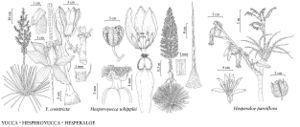Hesperaloe
in S. Watson, Botany (Fortieth Parallel), 497. 1871.
| Taxon | Illustrator ⠉ | |
|---|---|---|
 | Yucca constricta Hesperoyucca whipplei Hesperaloe parviflora | Bee F. Gunn Bee F. Gunn Bee F. Gunn |
Plants perennial, cespitose, acaulescent, semisucculent, primarily short to long-rhizomatous. Leaves in basal rosettes; blade linear, thick and striate-ridged abaxially, margins with threadlike, detaching filaments, apex frayed or with hard spine. Inflorescences paniculate [racemose], loose, 3–8-branched. Flowers bisexual; perianth narrowly tubular to broadly campanulate; tepals 6; stamens 6, inserted on receptacle or at tepal bases, included; filaments glabrous; anthers sagittate, with septal nectaries; receptacle fleshy; ovary superior; style slender, barely exceeding tepals. Fruits capsular, ovoid, dehiscence septicidal. Seeds many, black, flattened. x = 30.
Distribution
Arid regions of Tex. and Mexico (Coahuila), Arid regions of Tex. and Mexico (Nuevo León), Arid regions of Tex. and Mexico (San Luis Potosí), Arid regions of Tex. and Mexico (Sonora)
Discussion
Species 5 (2 in the flora).
Hesperaloe parviflora, and to a much lesser extent H. funifera, are cultivated in the semiarid and arid Southwest. The original distribution of H. parviflora is likely much obscured because of a long history of roadside and ornamental plantings throughout the area.
Selected References
None.
Lower Taxa
Key
| 1 | Flowers green, tinged with purple, broadly campanulate; leaf blade yellowish green, 1–2 m × 2–5 cm. | Hesperaloe funifera |
| 1 | Flowers rosy red to salmon, narrowly tubular; leaf blade dark green, 1–1.25 m × 2.5 cm. | Hesperaloe parviflora |
"thick" is not a number.